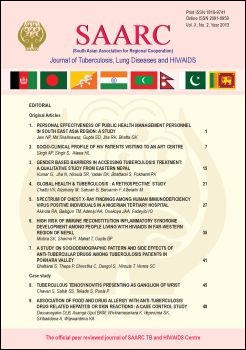High Risk Of Immune Reconstitution Inflammatory Syndrome Development Among People Living With HIV/AIDs In Far-Western Region Of Nepal
DOI:
https://doi.org/10.3126/saarctb.v10i2.9711Keywords:
IRIS, CD4, HIV, NepalAbstract
Introduction: Absolute CD4+ cell counts and CD4/CD8 ratio continue to be an important marker for clinical management of human immunodefi ciency virus (HIV) infection and diagnosis of AIDS. CD4/ CD8 ratio has been also used for prediction of immune reconstitution infl ammatory syndrome (IRIS). The objective of the study was to determine the immunological status in HIV infected people taking anti retroviral therapy (ART) on the basis of CD4+ level and to assess the risk of development of (IRIS) on the basis of CD4+ /CD8+ ratio.
Methodology: The study was carried out at Antiretroviral Therapy Centre of Seti Zonal Hospital (SZH), Dhangadi in Western region of Nepal; the second biggest ART center. The study included 760 HIV infected heterosexual, migrant laborer to India from Nepal and their spouses and children. CD profi le was enumerated by FACS Count System.
Results: Out of 760, 33(5%) had normal (between1-4) CD4/CD8 ratio, 727 (95%) had abnormal ratio (less than1) of CD4/CD8. The chance of getting IRIS after ART treatment initiation in HIV infected people was 47% among which 30% found to be in high risk of getting IRIS (having CD+/CD8+ ratio less than 0.15) and 17% had chance of immune reconstitution inflammatory syndrome (IRIS) in future course of treatment (having CD+/CD8+ ratio between 0.15-0.30).
Conclusion: The study provides the first baseline data on CD4, CD8, and CD4+/CD8+ ratio in HIV infected people in far-western region of Nepal and will sensitize the clinician about the risk of developing IRIS during ART treatment. Furthermore no test is currently available to establish a IRIS diagnosis. Standardized disease-specific clinical criteria for common infectious manifestations of the disease should be developed.
SAARC Journal of Tuberculosis, Lung Diseases & HIV/AIDS; 2013; X(2); 35-40
Downloads
Downloads
Published
How to Cite
Issue
Section
License
Copyright © SAARC Tuberculosis and HIV/AIDS Centre (STAC), all rights reserved, no part of this publication may be reproduced, stored in a retrieval system or transmitted in any form or by any means without prior permission of the STAC.





